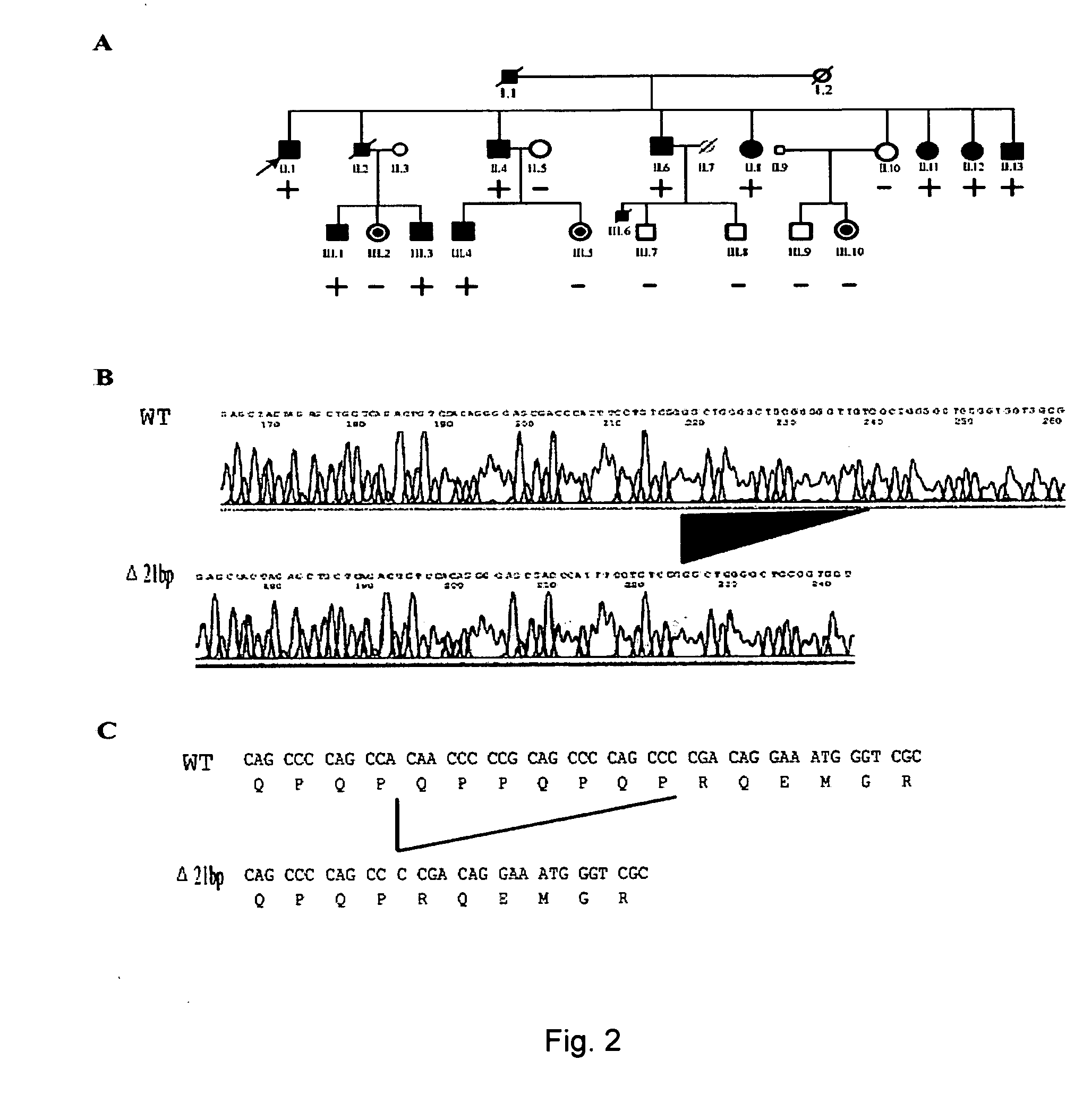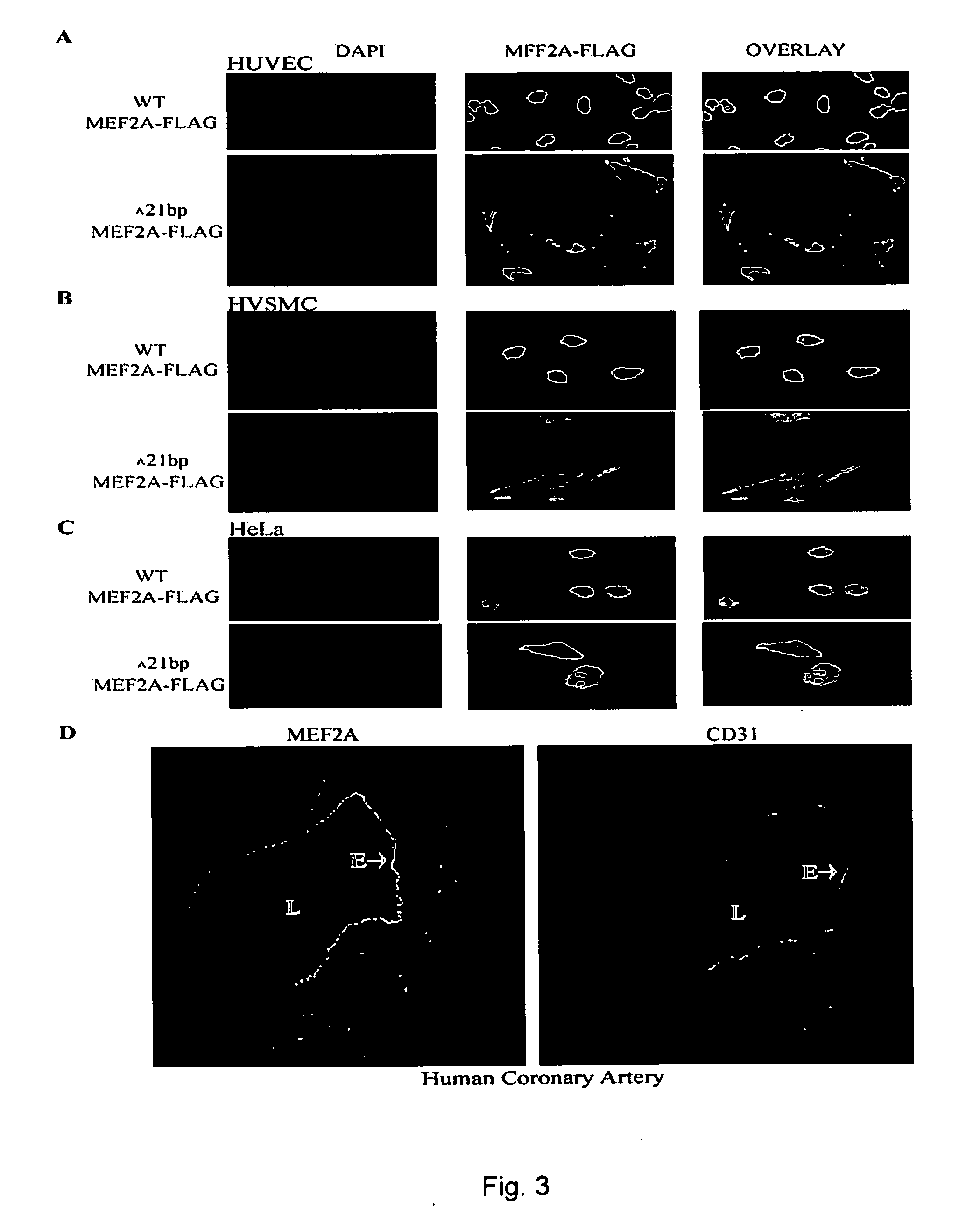Pathogenic gene for coronary artery disease
a pathogenic gene and coronary artery disease technology, applied in the field of myocyte enhancer factor 2a (mef2a) gene, can solve the problems of large burden of cad on the u.s. health care system, indirect costs totaling approximately >$133 billion, and little information about the genetic basis of the diseas
- Summary
- Abstract
- Description
- Claims
- Application Information
AI Technical Summary
Benefits of technology
Problems solved by technology
Method used
Image
Examples
example 1
[0143] We studied a large family with 13 patients that demonstrate an autosomal dominant pattern of CAD / MI (kindred QW1576 in FIG. 1, Table 1). CAD was defined as any previous or current evidence of MI (based on the existence of at least two of the following: chest pain of >30 minutes duration, ECG patterns consistent with acute myocardial infarction, or significant elevation of cardiac enzymes), percutaneous coronary angioplasty (PTCA), coronary artery bypass surgery (CABG), or coronary angiography with >70% stenosis. PTCA is one of the most common non-surgical treatment for opening obstructed coronary arteries. A catheter with a deflated balloon at its tip is inserted and advanced into the narrowed part of a coronary artery. The balloon is then inflated, which compresses the plaque and enlarge the inner diameter of the coronary artery to allow blood to flow more easily. A stent is sometimes placed to keep the arteries open. The balloon is then deflated and the catheter removed. Fi...
example 2
Identification of Three Novel Mutations in MEF2A Associated with Coronary Artery Disease and Myocardial Infarction
[0189] Here we report the results from mutational analysis of MEF2A in 200 independent patients with CAD / MI (males<55 years and females<60 years of age) and 200 individuals with normal angiograms.
Methods
[0190] Mutational analysis was carried out using single strand conformation polymorphism (SSCP) and DNA sequence analyses. The functional consequence of the newly-identified MEF2A mutations were examined using a transcription activation assay with the ANF-700p-luciferase reporter gene and transient transfection of wild type or mutant MEF2A proteins in HeLa cells. The results are shown in FIG. 9.
Results
[0191] The three novel mutations were identified in exon 7 of MEF2A in four of 200 CAD / MI patients (2%), and none of the mutations were detected in 200 normal individuals. These mutations include N263S identified in two independent CAD / MI patients, P279L in one patien...
example 3
[0193] To test if the CAG repeat in MEF2A is a significant genetic factor for premature myocardial infarction, 190 cases and 199 controls were randomly selected from GeneQuest and the general populations, to be genotyped. The distributions of CAG repeats within cases and controls are shown in FIG. 10. A logistic regression assuming a logit relationship between the phenotype and the underlying molecular determinant (the cumulative repeats contained in the genotype) was used to assess the effects of the CAG repeat. The analysis results demonstrate a slight decrease of the log of disease risk odds (−0.04) for each repeat increase but not up to a statistical significance (P=0.53), suggesting that this repeat may acts as a neutral site as a conventional microsatellite in non-coding regions does.
PUM
| Property | Measurement | Unit |
|---|---|---|
| thick | aaaaa | aaaaa |
| single strand conformational polymorphism analysis | aaaaa | aaaaa |
| Pedigree structure | aaaaa | aaaaa |
Abstract
Description
Claims
Application Information
 Login to View More
Login to View More - R&D
- Intellectual Property
- Life Sciences
- Materials
- Tech Scout
- Unparalleled Data Quality
- Higher Quality Content
- 60% Fewer Hallucinations
Browse by: Latest US Patents, China's latest patents, Technical Efficacy Thesaurus, Application Domain, Technology Topic, Popular Technical Reports.
© 2025 PatSnap. All rights reserved.Legal|Privacy policy|Modern Slavery Act Transparency Statement|Sitemap|About US| Contact US: help@patsnap.com



